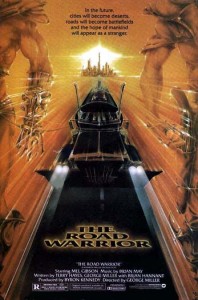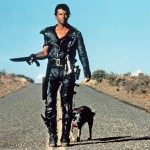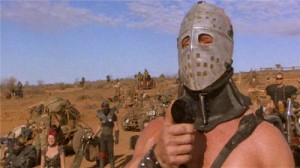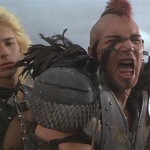With The Book of Eli currently in theaters, film critic Roger Ebert tweeted on January 17 that “No non-apocalyptic future is listed by Wikipedia.” We’re still waiting to see what happens here in reality, of course, but in films, novels, and comic books the world has been wiped out many times over by various forms of zombies, plagues, and — the old standby — nuclear annihilation.
 For me, no film has done the postapocalyptic thing better than Australian director George Miller’s 1981 action epic The Road Warrior. A sequel to 1979’s Mad Max, also directed by Miller, it was released Down Under as Mad Max 2. Max is played by Mel Gibson, but in the U.S. version of Mad Max his voice is dubbed, along with most of the other actors’, due to a concern that their thick Aussie accents and slang would be too difficult for American audiences to understand. (Fortunately, there’s a DVD that contains both the original audio track and the dubbed version.)
For me, no film has done the postapocalyptic thing better than Australian director George Miller’s 1981 action epic The Road Warrior. A sequel to 1979’s Mad Max, also directed by Miller, it was released Down Under as Mad Max 2. Max is played by Mel Gibson, but in the U.S. version of Mad Max his voice is dubbed, along with most of the other actors’, due to a concern that their thick Aussie accents and slang would be too difficult for American audiences to understand. (Fortunately, there’s a DVD that contains both the original audio track and the dubbed version.)
Miller is sometimes confused with another director named George Miller — that one directed The Man From Snowy River, a 1982 Australian film. The Road Warrior‘s Miller, however, went on to direct The Witches of Eastwick (1987) and Happy Feet (2006) as well as produce films in various genres, including the suspense thriller Dead Calm (1989) and the Oscar-winning children’s film Babe (1995). He also directed arguably the best segment of Twilight Zone: The Movie (1983), “Nightmare at 20,000 Feet,” in which John Lithgow plays an airline passenger who keeps seeing a monster on the wing of the plane. If you watch closely, with the pause button nearby, you’ll find two frames in which Lithgow’s eyes actually pop out of his head.
 If you haven’t seen Mad Max, don’t worry — The Road Warrior is a self-contained story that makes few references to the events of the first film and thus stands on its own. Max, as established in the film’s opening narration, is a “broken-down shell of a man,” an ex-cop who lost everything when his wife and son were run down by a biker gang. And that’s pretty much all you need to know. (Gibson’s new film, Edge of Darkness — his first as an actor since 2002’s Signs — has him playing a cop seeking revenge for his daughter’s murder.)
If you haven’t seen Mad Max, don’t worry — The Road Warrior is a self-contained story that makes few references to the events of the first film and thus stands on its own. Max, as established in the film’s opening narration, is a “broken-down shell of a man,” an ex-cop who lost everything when his wife and son were run down by a biker gang. And that’s pretty much all you need to know. (Gibson’s new film, Edge of Darkness — his first as an actor since 2002’s Signs — has him playing a cop seeking revenge for his daughter’s murder.)
It’s implied that the “apocalypse” that shattered this particular world was some kind of nuclear war, but no details are given. The only hint comes from the opening narration: “Gone now. Swept away. For reasons long forgotten, two mighty warrior tribes went to war and touched off a blaze which engulfed them all.”
Once the narration ends we are thrust literally head-on into this world, a vast desert wasteland of nothing except a long stretch of road upon which men scavenge for food and gasoline.
 Max reluctantly becomes involved with a group of settlers who live in an oil-refinery compound, right before a gang of marauders led by a hockey-masked figure known as the Lord Humungus attempts to invade the compound for its fuel reserves.
Max reluctantly becomes involved with a group of settlers who live in an oil-refinery compound, right before a gang of marauders led by a hockey-masked figure known as the Lord Humungus attempts to invade the compound for its fuel reserves.
Despite being a bleak film overall, there are wonderful little moments of humor in The Road Warrior — brief but welcome — that show humanity isn’t completely lost. One of my favorites is the exchange that takes place between compound leader Pappagallo (Mike Preston), his head mechanic (Steve J. Spears), and the assistant mechanic (Kristoffer Greaves).
 The action scenes in The Road Warrior have a ferocious kinetic energy to them, propelled by fender-mounted cameras and amazing stunt work, all edited for maximum impact. There’s probably no greater example of this than the fate of Vernon Wells’s character, Wez: energetic cinematography and editing come together to make you feel the impact of a head-on collision between Humungus’s vehicle and a tanker truck. The final action sequence is 15 minutes long and contains one of the finest on-screen vehicle chases ever filmed. The film also gets some help from an exciting score by Australian composer Brian May (not to be confused with the guitarist for Queen).
The action scenes in The Road Warrior have a ferocious kinetic energy to them, propelled by fender-mounted cameras and amazing stunt work, all edited for maximum impact. There’s probably no greater example of this than the fate of Vernon Wells’s character, Wez: energetic cinematography and editing come together to make you feel the impact of a head-on collision between Humungus’s vehicle and a tanker truck. The final action sequence is 15 minutes long and contains one of the finest on-screen vehicle chases ever filmed. The film also gets some help from an exciting score by Australian composer Brian May (not to be confused with the guitarist for Queen).
The Road Warrior was followed by another sequel in 1985, Mad Max Beyond Thunderdome. It was also followed by many imitators, but very few came close to matching its intensity. (Not even Thunderdome was able to touch it.)
Miller and Gibson tried to reunite for a fourth film, Fury Road, early last decade, but for various reasons, including the war in Iraq, the production was canceled. Now it’s being revived again, but Gibson will only be involved as a producer. Tom Hardy (RocknRolla, the upcoming Inception) will supposedly take over as a younger version of Max in this rewritten “reboot” of the franchise.




Comments